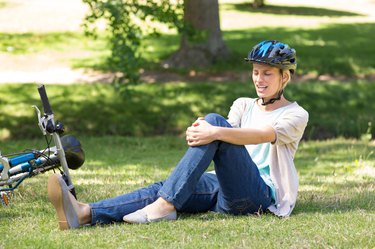
Nothing slows down your cycling routine more than prolonged soreness. Knee pain while cycling is usually a symptom of another problem. In the case of pain on the inner side of the knee, the culprit is almost always the position of your cycling cleat. You can adjust your foot and seat position to eliminate the pain, but take care not to over-adjust and risk trading your knee pain for a different type of soreness.
Cycling Pain-Free
Video of the Day
Cycling and pain shouldn't be synonymous; the vast majority of people with different proportions and levels of fitness can all be fitted properly for a bicycle, giving them a pain-free riding experience. Proper fit, however, is difficult for non-professionals to achieve, so many cyclists end up with back, knee, and neck pain that stems from a poor riding position. This problem is easily remedied with careful adjustment. If you're not sure you want to attempt an adjustment on your own, your local bike shop can help you get things just right.
Video of the Day
What Your Knee Needs
Knee pain can be separated into four distinct areas. The front and back of the knee, known as the anterior and posterior, usually get their pain from the actual exercise of pedaling rather than the bike. Pain on the sides of the knees, known as the medial and lateral areas of the knee, is usually a mechanical problem that stems from the position of your cycling shoes. By adjusting the cleat, you can eliminate the problem yourself.
Fighting Medial Pain
There are two types of medial pain caused by an improperly set cleat. If your cycling cleat is mounted too close to the inside edge of the bottom of your cycling shoe, you can develop medial pain; an easy solution is to move the cleat outwards, shifting your knee away from your top tube and re-centering your pedaling pressure onto the center of the joint. Alternatively, your pain could be caused by a poorly rotated cleat, where your heels are rotated too close to the bike. You can adjust the cleat to point your toes in slightly, which should eliminate the pain.
Taking Care of Your Joints
You can't expect your pain to be eliminated over night. Give your joints a few days of rest after making adjustments and start back with a gentle cycling routine to determine if you've properly diagnosed your source of pain, or if further adjustment is needed. If your soreness persists, seek out a professional bike fitter to double-check your adjustment and consult a physician to determine if there's a more sinister cause of your pain. An injury to the tendons, ligaments, or muscles around the knee should be taken very seriously.